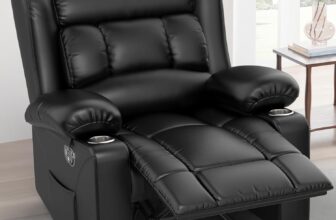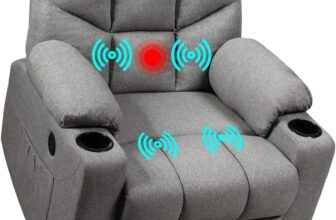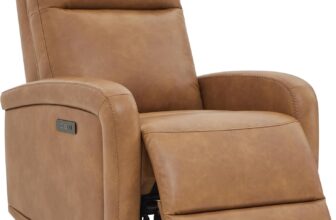3 Best Real Leather Recliner Chairs 2025
Recliners Guide is reader-supported. As an Amazon Associate, I earn from qualifying purchases. Learn more about our process here.
When investing in a recliner, real leather stands in a class of its own. Unlike faux alternatives, genuine leather is not only more durable but also matures beautifully over time, developing a rich patina that enhances both character and comfort. Its natural breathability adjusts to your body’s temperature, making it cool in summer and warm in winter—something synthetics can’t match. Real leather is also highly resistant to wear and tear. While faux leather tends to peel, crack, or fade after a few years, a well-maintained genuine leather recliner can last decades, making it a smarter long-term investment. There’s an unmistakable richness to the texture and scent of real hide that no imitation can replicate. If quality, longevity, and timeless style matter, a real leather recliner is the clear and confident choice. It’s not just furniture—it’s a piece that grows with you, both in comfort and value.
3 Best Real Leather Recliner Chairs in 2025
(1) Watson & Whitely Top-Grain Leather Power Recliner Chairs
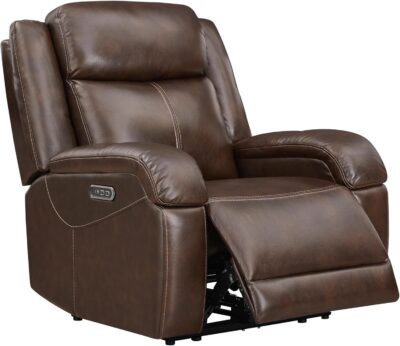
“The button mechanisms to recline and adjust the leg and head rest work smoothly and easily.” – my-2-cents
I’ve spent a few hours in this chair now, and I can confidently say it was a solid purchase. I’m around 5’10”, and the fit is just right — the seat depth, the back support, even the headrest — everything lines up nicely. The leather feels cool at first, but after a few minutes it adjusts to body temperature, which I really like. The head section is adjustable too, and that makes a big difference for getting that just-right position. This thing’s heavy — over 120 pounds — but that actually gave me some peace of mind. It feels stable and built to last. It’s not one of those plush, sink-in chairs; it’s medium-firm with enough padding to be comfortable without sagging over time. The recline is smooth, the footrest rises almost level with the seat, and with a small pillow under my ankles, I can sit like that for hours.
There are some smart design details I appreciate. The armrest has a nice crease where the remote naturally stays put. The controls are simple — separate buttons for the backrest, footrest, and headrest — plus a bonus feature that lets you raise the back while keeping your feet up, which I love. Assembly took maybe 30 minutes total, from unboxing in the driveway to relaxing in the living room. Everything was packed securely and easy to handle, though I’d recommend a second set of hands because of the weight. The power cord is around 10 feet and includes a handy USB port I use to charge my iPad. Overall, it’s a well-thought-out piece of furniture, functional, sturdy, and comfortable. I’d absolutely recommend it.
(2) Genuine Leather Power Swivel Glider Recliner for Adults
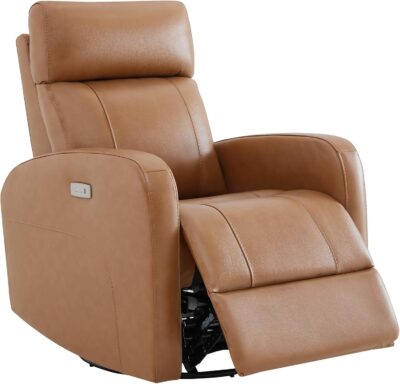
“leather looks and feels great. it is so quiet and smooth. if it holds up it is perfect.” – kathy
We needed a recliner that could squeeze into a smaller office space, and this one turned out to be a perfect match. It’s slim without feeling skimpy — I never feel cramped when sitting in it. And while I initially bought it for the office, it quickly became our go-to spot for just about everything. It reclines and rocks, which makes it ideal when I’m soothing our baby, and my wife loves sinking into it to watch sports.
The leather is soft, cool to the touch, and didn’t have any weird chemical smell out of the box. It’s definitely on the heavier side, but that adds to its sturdy feel. I’m 5’4” and finding a chair with proper neck and back support has always been tough for me. But this one surprised me — the headrest hits right at my neck instead of pushing my head forward, which is rare.
From seat to the headrest’s lower crease is around 17.5”, and my shoulders land right at that crease — which places the support exactly where I need it. The armrests are a comfortable height too, about 9.5” from seat to top. Not too low, not too high — just right to rest your arms without shrugging or slouching.
The seat feels supportive with a nice bit of lumbar comfort, and at 21” wide, I don’t feel like I’m leaning just to reach the armrests. The seat sits about 19” off the ground, and for me, that’s a comfortable height for getting in and out without any struggle. I can’t speak for the power recline since I’m more of a rocker — especially when I’ve got grandbabies in my lap — but overall, this chair really surprised me. In the best way.
3) CHITA Genuine Leather Power Recliner with Adjustable Power Headrest
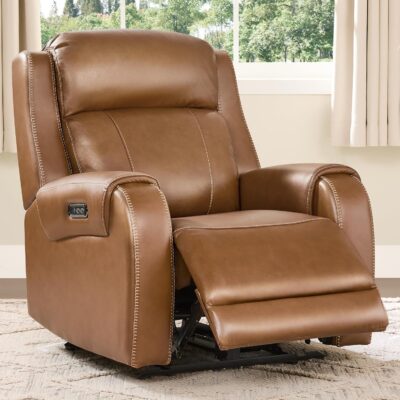
I’ve been through enough furniture hunts to know that finding something compact, comfy, and solidly built can be tricky. But this wall-hugger recliner really worked for my small living room setup. It only needed a few inches of clearance from the wall, and I was able to push it almost flush without sacrificing the recline—it slides forward instead of back, which makes a big difference in tighter spots.
The leather feels soft and durable, and I appreciate that it’s real on the areas that matter—where your skin actually touches. The overall build feels solid too, and I like knowing it’s made from certified wood and materials that don’t off-gas. The seat holds shape nicely, and it supports my weight (and more) without feeling flimsy.
The power motor is quiet, which is nice when I’m trying to unwind in peace, and the USB-C port keeps my phone charged without needing extra outlets. Assembly? Barely a chore—just slid the back onto the base and it was done in minutes. Fits right through a standard door, too. No drama.
Think Like This Before you Plan to Buy a Real Leather Recliner
1) Is the Leather 100% Top-Grain or Full-Grain Leather?
When considering a high-quality leather recliner, one of the most important questions to ask is whether the upholstery is 100% top-grain or full-grain leather. These terms are not marketing fluff — they refer to specific grades of leather that differ significantly in durability, comfort, and aging characteristics.
Full-grain leather is the highest quality available. It’s made from the top layer of the hide and includes all the natural grain. This type of leather has not been sanded or buffed to remove imperfections, which means it retains the hide’s strongest fibers. Full-grain leather develops a rich patina over time and is exceptionally durable — often lasting decades with proper care. It’s commonly found in luxury furnishings and heirloom-quality furniture.
Top-grain leather is the next best grade. Like full-grain, it’s derived from the top layer of the hide, but it has been lightly sanded to remove blemishes and inconsistencies. The result is a more uniform appearance, which some buyers prefer. Top-grain leather is still strong and supple but doesn’t develop as much of a patina and is slightly less breathable.
Manufacturers may use terms like “genuine leather” or “bonded leather,” but these do not equate to top-grain or full-grain in quality. In many cases, only the seat and backrest — areas that come into direct contact with the body — are made of real top-grain leather, while sides and backs are covered in vinyl or split leather.
Always verify with the seller. If it’s truly 100% full-grain or top-grain leather throughout, it should be clearly stated in the product specs — and reflected in the price. When it comes to leather, transparency is everything.
Certainly — here’s a 300-word professionally written article addressing the question: “Are all contact areas real leather or just some parts?”
2) Are All Contact Areas Real Leather or Just Some Parts?
In most mid-range to premium recliners, the term “leather match” is common. This means the seat, backrest, and inner arm panels—the parts your body touches most—are upholstered in real leather, typically top-grain. However, non-contact areas like the sides and back are often covered in vinyl or polyurethane engineered to mimic the texture and color of real leather. This technique helps reduce cost without sacrificing the visible and tactile appeal of genuine hide.
While this hybrid approach isn’t necessarily deceptive, it’s critical for buyers to understand what they’re getting. Over time, synthetic materials can age differently from leather. For instance, vinyl may crack or peel after a few years, especially in high-humidity environments, while real leather will patina and soften.
In high-end recliners, you’re more likely to find 100% leather coverage, but even then, it’s worth confirming whether the entire chair is upholstered in full-grain or top-grain leather, or just parts of it.
Don’t rely on labels alone. Ask the seller directly: Are all touchpoints covered in real leather? What about the sides, back, and undersides? A reputable manufacturer or seller should provide a materials breakdown in writing.
Ultimately, knowing what materials are used across the chair helps set realistic expectations and ensures your investment delivers both comfort and longevity—not just clever styling.
3) How Thick Is the Leather (in Millimeters)?
Leather thickness might not be the first detail that comes to mind when purchasing a recliner, but it can be a defining factor in terms of durability, feel, and overall value. Measured in millimeters or ounces (1 oz ≈ 0.4 mm), leather thickness determines how well the upholstery holds up to daily use, stretching, and potential scuffing.
For recliners, the industry standard for top-grain leather typically ranges between 0.9 mm to 1.4 mm. This is considered an optimal thickness for furniture — supple enough for comfort, yet thick enough to resist tearing or early wear. Full-grain leathers, which retain the outermost layer of the hide, often fall on the higher end of this range and provide added durability, along with a more natural, less processed look.
Manufacturers may not always advertise leather thickness, so it’s wise to ask directly or check the product specifications. A thickness below 0.8 mm may feel more delicate and is more susceptible to punctures, especially on high-use surfaces like seat cushions and armrests. On the other hand, leather over 1.4 mm can be stiff unless expertly tanned or broken in, which could affect comfort — especially in recliners where flexibility matters.
Also worth noting: leather that’s too thick is not always better. Some recliners use split leather or heavily corrected hides that are thicker but lack the tensile strength and grain pattern of higher-quality top-grain or full-grain leather.
In short, aim for a thickness between 1.0 mm and 1.4 mm for an ideal balance of softness, structure, and long-term performance. Thicker leather is a smart investment if you want your recliner to age gracefully while withstanding years of everyday use without losing its shape or comfort.
4) Is the Leather Treated or Protected?
Most leather used in furniture today is treated to some degree. Top-grain leather, commonly found in high-quality recliners, is often finished with a light protective coating—a transparent layer designed to shield the surface from stains, moisture, and UV damage. This finish makes the leather easier to clean and more resistant to wear from everyday use.
More luxurious aniline leather, on the other hand, is dyed with soluble dyes that preserve the hide’s natural surface. It’s rarely protected with a topcoat. While aniline leather feels softer and richer to the touch, it’s also more porous and prone to staining—meaning spills must be cleaned immediately to avoid permanent marks.
There’s also semi-aniline leather, which offers a middle ground. It’s treated with dye and a small amount of protective finish, offering a balance between the soft, natural look of aniline and the durability of protected leathers.
Buyers should ask: Is the leather finished with a polyurethane or acrylic topcoat? Does it have stain resistance or UV protection? A clear answer will help set expectations. For homes with children, pets, or high sunlight exposure, protected leather is often the more practical choice.
Treated leather tends to age more evenly and resists fading, cracking, and discoloration. However, it can lack the patina and subtle texture changes that untreated leather develops over time—a quality some buyers actively seek for its authenticity.
Ultimately, understanding how the leather is treated helps you plan for upkeep, cleaning methods, and longevity—ensuring your investment is not just beautiful at purchase, but remains functional and appealing for years to come.

